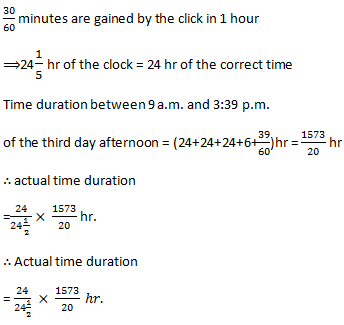
Calendar
A calendar is a specific measure of time. The smallest unit of calendar is a day. A day is an average time in which the earth completes one round on its axis. The time in which the earth travels around the sun is known a solar year.One must remember the following points pertaining to a calendar:
(i) A solar year has 365 days 5 hours 48 minutes and 48 seconds. An ordinary year has 365 days. In order to remove this difference, every fourth year has 366 days and every fourth century is a leap year but no other century is a leap year.(ii) The number of days more than the complete number of weeks in a given period is the number of odd days for that period.
(iii) In an ordinary year there are 52 weeks and one odd day.
- In a leap year there are 52 weeks and two odd days.
- 100 years contain 5 odd days.
- 200 years contain 3 odd days.
- 300 years contain 1 odd day.
- 400 years contain 0 odd days.
Clock
A clock or a watch is an instrument which shows time at a moment. The following points must be noted:(i) The face or dial of a watch or a clock is a circle which is divided into 60 equal parts.It is called minute spaces
(ii) A clock or a watch has two hands, the smaller one is called hour hand the larger one is called minute hand
(iii) The hours are denoted from 1 to 12 and the minutes are indicated by marking from 1 to 60.
(iv) In one hour the minute hand passes over 60 minute spaces while the hour hand passes over 5 minute spaces. That is, in 60 minutes the minute hand gains 55 minute spaces (= 330°) on the hour hand.
(v) In every hour ––
(a) The hands coincide once,
(b) They point in opposite directions once and in this position, they are 30-minute spaces apart.
(c) They are twice at right angles and in these positions, they are 15 minute spaces apart

(a) The hands coincide once,
(b) They point in opposite directions once and in this position, they are 30-minute spaces apart.
(c) They are twice at right angles and in these positions, they are 15 minute spaces apart

Solved Questions from Previous Papers
Question. 1
(a) 60°
(b) 45°
(c) 75°
(d) 90°
Question. 2

Question. 3
(a) 3 p.m.
(b) 3.16 p.m.
(c) 2.52 p.m.
(d) 2.40 p.m.
Question. 4
(a) 3.22 p.m.
(b) 3.16 p.m.
(c) 2.52 p.m.
(d) 2.40 p.m.
Question. 5

(c) 10 min and 40 min
(d) None of these
Question. 6
(a) Loses 90 minutes
(b) Gains 90 minutes
Question. 7

Question. 8
(a)

(b) 12 min past 8
(c) 16 min past 8
(d) 11 min past 8
Question. 9

Question. 10
(a) 4 p.m
(b) 3 p.m.
(c) 1 p.m.
(d) 2 p.m.
Question. 11
(a) Wednesday, 6p.m.
(b) Wednesday, 7p.m.
(c) Thursday, 8 p.m.
(d) Wednesday, 9 p.m
Solutions:
Ans:1 (C)
Hint:
Ans: 2 (B)
Hint:
If both the hands start moving together from the same position they will coincide after 
Ans: 3 (C)
Hint:
Ans: 4 (B)
Hint:
The second clock gains(24+24+24+4 minutes)Ans: 5 (A)
Hint:
The hands of the clock will be at right angels after 5 p.m. once the minute hands has traversed 150° + 90°=240° over the minute hand.
Note that 330° are gained in 60 minutes.
Ans: 6 (D)
Hint:
Ans: 7 (B)
Hint:
In order to be coincident the minute hand must traverse 240° over the hour hand
Ans: 8 (A)
Hint:
To be in a straight line the minute hand must traverse 60° over the hour hand.
Ans: 9 (A)
Hint:
5 minute spaces = 30°
Ans: 10 (B)
Hint:
Ans: 11 (D)
Hint:








